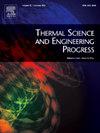Net zero carbon captive power generation using compressor inlet air cooling approach
IF 5.1
3区 工程技术
Q2 ENERGY & FUELS
引用次数: 0
Abstract
The study examines converting petroleum sector captive power plants to combined cycle power plant (CCPP) with CO2 mitigation. The study used a novel approach to cool the compressor inlet air with vapour absorption refrigeration systems (VARS). VARS used steam bled by pass-out system from a steam turbine. The study selects the Rajasthan refinery captive power plant in India as a case study. The model predicts plant performance under different inlet conditions, factoring in local climate with amine-based CO2 capture system. The study employed a thermodynamic model to analyse the effects of varying compressor inlet air temperature by using VARS with CO2 emission mitigation. This study has shown that a CCPP integrated with VARS increases the gas turbine power output in the range of 0.42 MW to 5.74 MW as the compressor inlet temperature decreases from 40 °C to 15 °C. The combined power output increased by 4.69 MW at 15 °C and overall efficiency increased by 2.77 %, and maximum combined cycle efficiency reached 48.60 %, along with the capability to harvest condensed fresh water at a rate of 0.75 kg/s under ambient relative humidity of 30 % and 20 °C dew point temperature. When the plant is equipped with a CO2 capture system for the range of inlet air temperatures, the efficiency decreases to a range of 34.20 % to 31.43 %. However, the plant significantly reduces its CO2 emissions from 0.459 kg CO2/kWh to 0.0645 kg CO2/kWh i.e. comparable to renewable energy plants. Thus, the proposed system showcases its potential to contribute to a cleaner energy transition.
净零碳自备发电采用压缩机进气冷却方式
该研究探讨了将石油部门自备发电厂转换为联合循环发电厂(CCPP)并减少二氧化碳排放。采用蒸汽吸收式制冷系统(VARS)对压缩机进气进行冷却。VARS使用的蒸汽是由汽轮机排出系统排出的。本研究选择印度拉贾斯坦邦炼油厂自备电厂作为案例研究。该模型利用胺基CO2捕集系统预测了不同进口条件下工厂的性能。本研究采用一个热力学模型,通过使用具有二氧化碳减排功能的VARS来分析不同压缩机进气温度的影响。该研究表明,当压缩机进口温度从40°C降低到15°C时,集成了VARS的CCPP可将燃气轮机输出功率增加0.42 MW至5.74 MW。在环境相对湿度为30%、露点温度为20℃条件下,联合循环效率最高可达48.60%,集凝淡水效率可达0.75 kg/s。当工厂在进口空气温度范围内配备二氧化碳捕获系统时,效率下降到34.20%至31.43%的范围。然而,该工厂的二氧化碳排放量从0.459千克二氧化碳/千瓦时显著减少到0.0645千克二氧化碳/千瓦时,即与可再生能源工厂相当。因此,拟议的系统显示了其促进清洁能源转型的潜力。
本文章由计算机程序翻译,如有差异,请以英文原文为准。
求助全文
约1分钟内获得全文
求助全文
来源期刊

Thermal Science and Engineering Progress
Chemical Engineering-Fluid Flow and Transfer Processes
CiteScore
7.20
自引率
10.40%
发文量
327
审稿时长
41 days
期刊介绍:
Thermal Science and Engineering Progress (TSEP) publishes original, high-quality research articles that span activities ranging from fundamental scientific research and discussion of the more controversial thermodynamic theories, to developments in thermal engineering that are in many instances examples of the way scientists and engineers are addressing the challenges facing a growing population – smart cities and global warming – maximising thermodynamic efficiencies and minimising all heat losses. It is intended that these will be of current relevance and interest to industry, academia and other practitioners. It is evident that many specialised journals in thermal and, to some extent, in fluid disciplines tend to focus on topics that can be classified as fundamental in nature, or are ‘applied’ and near-market. Thermal Science and Engineering Progress will bridge the gap between these two areas, allowing authors to make an easy choice, should they or a journal editor feel that their papers are ‘out of scope’ when considering other journals. The range of topics covered by Thermal Science and Engineering Progress addresses the rapid rate of development being made in thermal transfer processes as they affect traditional fields, and important growth in the topical research areas of aerospace, thermal biological and medical systems, electronics and nano-technologies, renewable energy systems, food production (including agriculture), and the need to minimise man-made thermal impacts on climate change. Review articles on appropriate topics for TSEP are encouraged, although until TSEP is fully established, these will be limited in number. Before submitting such articles, please contact one of the Editors, or a member of the Editorial Advisory Board with an outline of your proposal and your expertise in the area of your review.
 求助内容:
求助内容: 应助结果提醒方式:
应助结果提醒方式:


